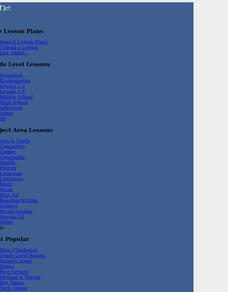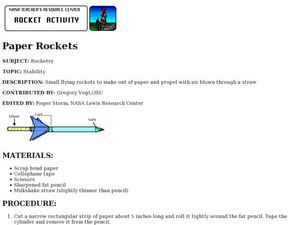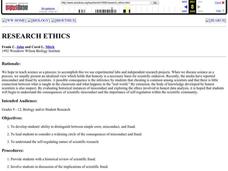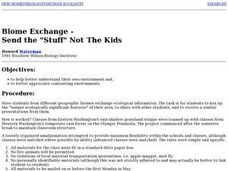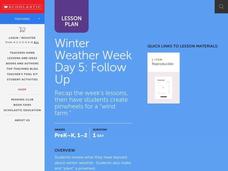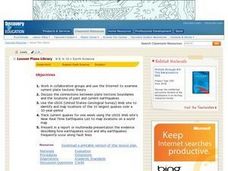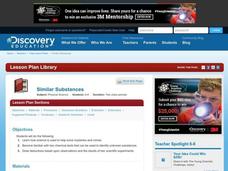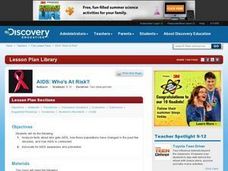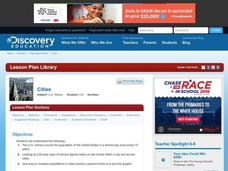Curated OER
First Contact
Sixth graders have an opportunity to enhance their computer skills by using Internet as a resource tool and a vehicle for global interaction with other students.
Curated OER
Propaganda: Making a Commercial
Seventh graders study different propaganda techniques. In groups, they write and perform a 60-second TV or radio commercial. Classmates rate the effectiveness of the commercial and whether or not they might buy the product.
Curated OER
Civil Service Reform: Senate Debates
High schoolers examine the 1883 Pendleton Civil Service Reform Act. They discuss the spoils system, answer discussion questions, read and analyze speeches, complete a worksheet summarizing their findings, and report their findings to the...
Curated OER
What is an Aquifer?
Students examine how an aquifer operates. They discuss the implications of the groundwater becoming contaminated. They work together to create an aquifer model to observe the connection between surface water and groundwater.
Curated OER
Trade Impasse
Learners examine the concept of free trade. They watch a video clip about this topic and write an essay comparing the opinions of the guests on the show. They research a country and role-play their decisions in international trade.
Curated OER
Paper Rockets
Students design, construct, and fly paper rockets that travel the greatest distance possible across a floor model of the solar system. They construct small flying rockets out of paper and propel them by blowing air through a straw.
Curated OER
E-mail Abbreviations
Students identify an abbreviation or acronym for communication purposes. Students write various messages using each correctly. Students make a list of the most common abbreviation and acronyms used currently.
Curated OER
Research Ethics
Students develop an ability to distinguish between simple error, misconduct and fraud. Students are lead to consider a widening circle of the consequences of misconduct and fraud. They expand their knowledge on the self-regulating...
Curated OER
Biome Exchange - Send the "Stuff" Not The Kids
Students exchange ecological information with students from different geographic biomes. They box up the "unique ecologically significant features" of their area, send the box to another class in another area and then receive a similar...
Curated OER
Winter Weather Day 5: Follow Up
Students participate in culminating activities for a winter weather unit. They discuss what they have learned about winter weather, and write a diamante poem using winter vocabulary words. Students also construct a pinwheel and explore...
Curated OER
Earthquakes And Fault Lines
Students discuss major causes of earthquakes and identify famous fault lines, access and map information about ten largest earthquakes in world from 1989 to 1998, and theorize about location of these earthquakes as they relate to Earth's...
Curated OER
The Case of Similar Substances
Students solve a crime mystery using chemical tests. They review the crime scenario and then become familiar with the procedure and results for two tests used to identify unknown powders. They perform the tests on the crime samples and...
Curated OER
Alaska Purchase Debate
Students examine the benefits and the challenges Alaska has presented to the United States. They research what the government and the people of the United States considered at the time of the purchase of Alaska in order to debate the...
Curated OER
Carter as President and Ex-President
Students examine how Presidents are judged during their time in office as well as afterwards. They conduct and Internet search for Jimmy Carter's inaugural address and write a news story about his address. Once they have written an...
Curated OER
Who's at Risk?
Students are asked what do they comprehend about HIV, such as: how does it get transmitted, and what happens to the body once someone contracts the virus. They discuss ways that people can avoid getting and spreading AIDS. Students...
Curated OER
Outdoor Photography with Digital Cameras
Students become familiar with perspective, composition and framing of pictures. In this photographing nature instructional activity, students photograph and then describe their pictures in a paragraph. Students build pictures to tell a...
Curated OER
Get to Know Birds
Students observe animals in their natural habitats. In this bird identification lesson plan, students observe birds by watching and listening and report on the sightings they made. Students also document bird signs such as tracks,...
Curated OER
The Future of Haiti
Learners analyze the future of Haiti. In this Haiti lesson, students research the economy of Haiti as they read several artcles and participate in group discussion. Learners then collaborate in small groups to propose...
Curated OER
Habitats of the World
Learners discover that the Earth supports many different animal habitats. In this habitat lesson students research different habitats of the world. Learners show how the animals in their habitat are adapted.
Curated OER
Cancer Research
High schoolers participate in a class demonstration to see how many Americans are affected by cancer in their lifetime. In this public health lesson, students are placed in situations that allow them to experience how relevant...
Curated OER
Mississippi River
Students study scanning and skimming techniques. In this research skills activity, students use the research techniques on print literature about the Mississippi River. Students prepare book talks on the literature they read.
Curated OER
Ivory Wars
Middle schoolers examine the controversy surrounding African trade. In this geography activity, students research the killing of elephants for ivory. Middle schoolers collaborate to report on the history of the ivory trade and its...
Curated OER
Rome's Rise To Power: The Republic
Students investigate the government structure of ancient Rome. In this government systems lesson, students compare and contrast the government of ancient Rome with the government of the United States.
Curated OER
Cities
Students examine U.S. Census figures. For this urban centers lesson, students compare city populations across the span of 50 years. Students create line graphs based on the data.
